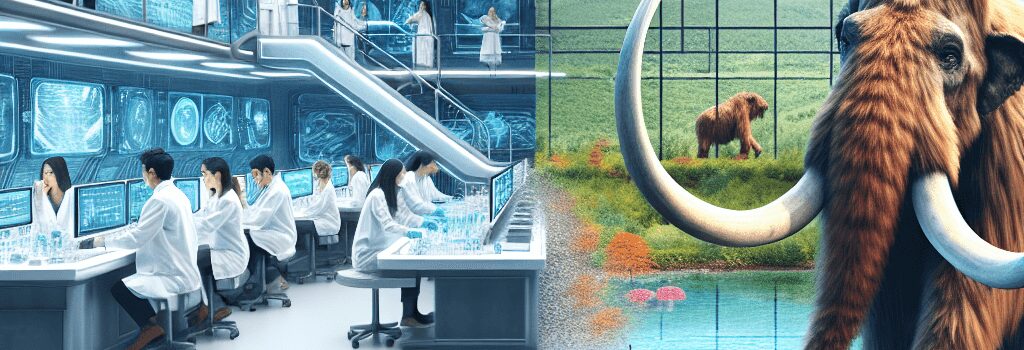Mammoth De-Extinction: Technological Marvel or Conservation Misstep?

By Nitin Sekar | Updated April 2025
Introduction: A Colossal Ambition in a Complex World
The start-up Colossal Biosciences has recently captured global attention by advancing gene-editing technology with the ambitious goal of reviving the woolly mammoth. Their roadmap, which includes generating stem cells from the Asian elephant—mammoth’s closest living relative—and creating genetically modified mice with mammoth-like coats, has propelled the company to a staggering valuation of $10 billion. Spearheaded by renowned figures such as Harvard and MIT professor George Church, this high-profile project claims that reintroducing these cold-tolerant hybrids to the Arctic could combat climate change by restoring grassland ecosystems and preserving permafrost.
Technical Milestones and Innovations
Colossal’s rapid progress in synthetic biology leverages state-of-the-art CRISPR technologies and advanced stem cell manipulation. Recent developments include:
- Stem Cell Engineering: The generation of robust stem cells from Asian elephants offers a promising platform for further genome editing.
- Genome Editing in Model Organisms: The creation of mice with extended, mammoth-like coats demonstrates precise control over genetic traits, setting the stage for more complex edits required for viable mammoth characteristics.
- Surrogate Technology: The planned use of captive Asian or African elephants as surrogates is technically challenging. The process would involve implanting a genetically modified embryo into a suitable host—a procedure that demands not only perfect genomic assembly but also immaculate reproductive success, a domain where even state-of-the-art biotechnology struggles.
Ecosystem Engineering: Theoretical Benefits Versus Experimental Evidence
Colossal’s environmental narrative suggests that reintroduced mammoths could graze the Arctic grasslands, scraping away snow to keep the ground cold and preserve permafrost. If successful, such intervention might slow the thawing of permafrost, thereby preventing the release of trapped greenhouse gases. However, the underlying science is far from settled:
- Past vs. Present Dynamics: While there is a well-circulated debate regarding trophic cascades—such as the reintroduction of wolves in Yellowstone—recent studies and reviews suggest that these ecological effects might be less pronounced than once believed.
- Elephant Ecology: Elephants, often hailed as keystone species, are also at the center of ecological debates. Although they are effective seed dispersers, research shows that domestic cattle and other animals can fill similar roles, complicating assumptions about the ecological void left by extinct megafauna.
- Mixed Signals in Carbon Sequestration: Some studies indicate that African forest elephants facilitate the growth of carbon-absorbing hardwoods, while other research shows that excessive tree damage in savannas might reduce overall carbon sequestration. These conflicting findings raise important questions about whether resurrected mammoths could truly tip the scale in favor of climate stabilization.
De-Extinction vs. Traditional Conservation: Ethical and Welfare Considerations
One of the most controversial technical and ethical challenges is the planned use of elephant surrogates for implanting mammoth embryos. The process carries significant risks and ethical dilemmas:
- Animal Welfare: Breeding elephants in captivity is fraught with challenges such as infertility, high rates of stillbirth, and psychological stress. The integration of a chimeric genome into an elephant surrogate could exacerbate these issues, subjecting both the surrogate mothers and resultant offspring to unforeseen complications.
- Long-Term Viability: Even if a viable mammoth calf is born, this creature may suffer from chronic health problems due to genomic inconsistencies or an inability to reconstitute the ancient gut microbiome, leading to digestive dysfunction. Such complications are a serious cause for concern in long-term conservation efforts.
- Cultural Disruption: Elephants rely on complex social structures and matriarch-led herd dynamics for survival. Disrupting these established cultural frameworks by introducing genetically modified animals in an unfamiliar environment could lead to significant behavioral and social hardships.
Deeper Analysis: The Role of AI and Data in Wildlife Conservation
Emerging technologies such as artificial intelligence and big data analytics are poised to revolutionize wildlife conservation. Instead of dedicating billions to de-extinction projects, tech innovations could be redirected to:
- AI-Driven Monitoring: Deploying AI-powered systems to track individual elephants, analyze migration patterns, and predict human-elephant conflict zones could lead to more proactive conservation strategies.
- Predictive Ecosystem Modeling: Advanced simulation models enable researchers to better understand complex trophic relationships, assessing whether reintroducing an extinct species could indeed balance ecological dynamics or inadvertently cause more harm.
- Alternative Protein Engineering: Investments in synthetic biology could better serve climate change mitigation by developing lab-grown meat or enhanced carbon-sequestering plants, thereby reducing the strain on natural habitats.
Deeper Analysis: Opportunity Costs and Strategic Investment Priorities
The allocation of resources towards mammoth de-extinction could sidestep pressing conservation needs. In regions like India, where wild Asian elephants survive amidst ongoing human-animal conflict, the funds and expertise currently invested in de-extinction might yield greater benefits if redirected towards:
- Mitigating Human-Elephant Conflict: Advanced surveillance and compensation schemes could help communities adapt and coexist with wild elephants more effectively.
- Habitat Connectivity: Restoring and connecting fragmented habitats using modern conservation science is crucial for the long-term survival of these magnificent creatures.
- Community-Based Conservation: Initiatives that empower local communities with monitoring tools, such as drone-based imaging and sensor networks, can enhance native conservation efforts without the risks associated with genetic interventions.
Conclusion: A Wake-Up Call for Evidence-Based Conservation
While Colossal Biosciences’ mammoth revival project is a remarkable demonstration of technological prowess, it raises serious doubts about the overall benefit to conservation. The scientific support for ecological interventions based on reintroducing extinct species remains shaky at best. Instead of risking animal welfare and misallocating billions, consideration should be given to proven methods powered by AI, improved ecosystem monitoring, and community-supported conservation programs. As we strive for a future that marries technology with environmental stewardship, it becomes critical to ask: Are we prioritizing impressive headlines over robust, ethically grounded solutions? For those who truly care about our climate, biodiversity, and animal welfare, the mammoth de-extinction journey may be a colossal misstep on the path to sustainable conservation.